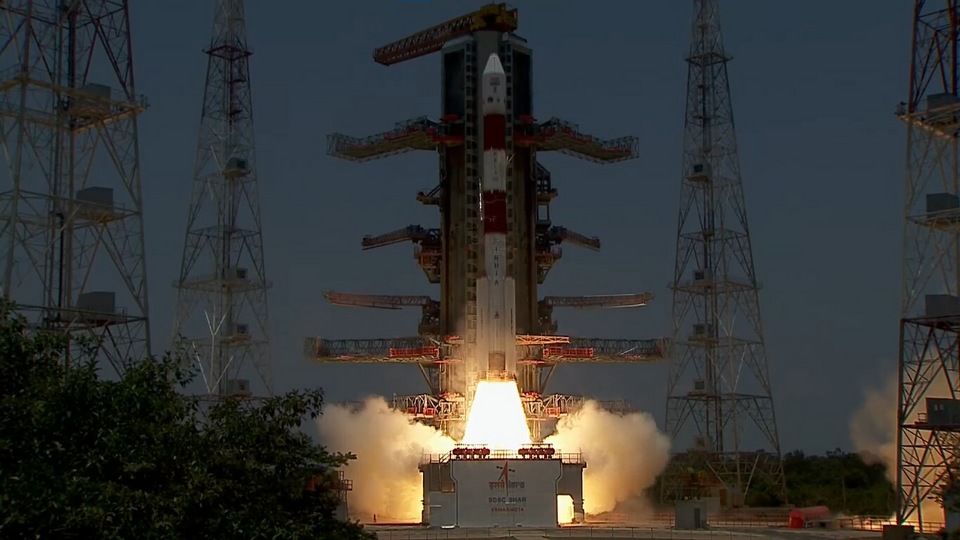Aditya-L1 launch highlights: All the action from India's historic solar mission as it happened
ISRO has successfully completed the launch of Aditya-L1 solar mission. The spacecraft is now enroute to Lagrange 1 point, where it will spend the next 5 years observing the Sun and learn about its corona as well as solar flares, coronal mass ejections, and solar storms. This blog is now closed.
ISRO has successfully launched the Aditya-L1 mission, India's first-ever space-based solar observatory. The launch took place at 11:50 AM and went without a hitch. Now, the spacecraft is on its way towards the Lagrangian point 1, which is a stable gravitational space between the Earth and the Sun. The same point is also occupied by the NASA Solar and Heliospheric Observatory (SOHO) spacecraft. The primary objective of the mission is to understand space weather, including its biggest factors such as solar flares, solar wind, coronal mass ejection (CME), and more. It is carrying a suite of seven different payloads to study different aspects of the Sun and develop a comprehensive data set.
According to ISRO, Aditya-L1 is carrying seven payloads to study the photosphere, chromosphere and coronal layer of the Sun, which will be done using electromagnetic and particle directors. While four of the payloads will be directly facing the Sun, the other three will conduct in-situ analysis from L1 of the solar particles and the solar fields. All the payloads will help scientists develop a greater understanding of the dynamics of solar weather, problems of coronal heating, pre-flare and flare activities, and more.
The seven payloads are - Visible Emission Line Coronagraph (VELC), Solar Ultra-violet Imaging Telescope (SUIT), Solar Low Energy X-ray Spectrometer (SoLEXS), High Energy L1 Orbiting X-ray Spectrometer (HEL1OS), Aditya Solar wind Particle EXperiment (ASPEX), Plasma Analyser Package for Aditya (PAPA), and Magnetometer (MAG).
Union Minister Nitin Gadkari calls Aditya-L1 mission a “historic achievement in the pursuit of scientific knowledge”
Union Minister Nitin Gadkari said on his X account, "A historic achievement in the pursuit of scientific knowledge! ISRO has triumphantly launched its first-ever space mission to study the Sun, #AdityaL1
This remarkable endeavor promises to unlock the secrets of our nearest star, shedding light on its mysteries and enhancing our understanding of space weather.
Kudos to the brilliant minds at ISRO who have made this mission possible. Your dedication and expertise continue to inspire us all. Here's to a bright future of solar exploration and groundbreaking discoveries".
ISRO gives Aditya-L1 mission update
ISRO posted on its X account, "The launch of Aditya-L1 by PSLV-C57 is accomplished successfully.
The vehicle has placed the satellite precisely into its intended orbit.
India's first solar observatory has begun its journey to the destination of Sun-Earth L1 point".
PM Narendra Modi congratulates ISRO scientists and engineers
After the launch of Aditya-L1, PM Narendra Modi posted on his X account and said, “After the success of Chandrayaan-3, India continues its space journey. Congratulations to our scientists and engineers at @isro for the successful launch of India's first Solar Mission, Aditya -L1. Our tireless scientific efforts will continue in order to develop better understanding of the Universe for the welfare of entire humanity”.
Let's catch up
If you have just joined us or missed the launch today, then don't worry. Here, we recap the important events so far.
Despite some concerns due to a solar storm striking the Earth just hours before the launch of the Aditya-L1 mission, the launch event took place successfully.
Aditya-L1 is India's first-ever space-based solar observatory which will be placed in the Lagrange 1 point between the Sun and the Earth, a stable gravitational spot.
The launch took place as per schedule at 11:50 AM, and so far three different stages have separated and we are waiting for the confirmation from ISRO about the separation of the 4th stage.
Difference between James Webb Space Telescope and Aditya-L1, explains Dr. Durgesh Tripathi
Unlike the James Webb Space Telescope and the Hubble Space Telescope which look at the universe, different star formations, and more, the Solar Ultra-violet Imaging Telescope (SUIT) payload aboard the Aditya-L1 spacecraft will specifically look at the Sun, says Dr. Durgesh Tripathi of the Inter University Centre for Astronomy and Astrophysics, Pune which designed the payload.
Aditya-L1 is multiwavelength, multi-instrument, and multidirectional, says Dr. Anil Bhardwaj
Dr. Anil Bhardwaj, director of the Physical Research Laboratory in Ahmedabad which developed the Aditya Solar wind Particle EXperiment (ASPEX) and Plasma Analyser Package for Aditya (PAPA) payloads, said after the launch, “First of all, let me tell you that Aditya-L1 is multiwavelength, multi-instrument, and multidirectional. Multiwavelength because it works on X-rays, UV, and visible spectrum. Multi-instrumental because there are 7 instruments on board, and multidirectional because it not only looks at the Sun but also around it”.
Aditya-L1 phase four separation underway
After the separation of the first three stages, the fourth and final separation is now underway. After this, the satellite will move towards its destination. The stage four separation will take about 30 minutes, meaning after the stage 3 has traveled for half an hour, the separation will occur.
Aditya-L1 mission has been successfully launched
ISRO, on September 2, has successfully launched India's first-ever space-based solar observatory, Aditya-L1. After the first and second rocket stage's separation, the payload was also separated at 2 minutes 40 seconds. The launch took place at Sriharikota.
The third stage separated successfully at the 900-second mark at an altitude of 2880 kilometers from the surface of the Earth.
4 mins to launch
The autonomous launch sequence has begun. ISRO will launch the PSLV-C57 rocket at 11:50 AM. Following the launch, there will be two different separation stages and two different cutoff stages before the Aditya-L1 spacecraft begins its journey towards the Lagrange 1 point.
With just 20 minutes to go, let us catch you up with the events so far
Yesterday, ISRO chief S Somnath said that after the Aditya-L1 launch, the next target for ISRO is Gaganyaan which will take place in the first week of October.
Chris Hadfield, former commander of ISS also congratulated India on its achievements with Chandrayaan-3 and hailed the technological prowess to build Aditya-L1.
The Aditya-L1 mission will launch at 11:50 AM and travel 1.5 million kilometers to reach the Lagrange 1 point, where it will observer the Sun for 5 years. During this time, it will study the Sun's corona, as well as solar flares, solar winds, and coronal mass ejections, that play a crucial role in space weather.
Former commander of the International Space Station speaks on Aditya-L1 mission
In a conversation with ANI, Chris Hadfield said, "So when we put something like Aditya-L1 up there in between us and the Sun to sense those things, to better understand how the sun works and the threats that it has to the earth, it's good for everybody for protecting us as people."
“But also, of course, our electrical grid, our internet grid, and all of the thousands of satellites that we count on that are up in orbit. Everybody on the Earth is counting on technology just to have electricity in their homes and businesses to have communication," he added.
“We are counting on a really complicated interconnected global electric and data system...it's really useful information, not just for ISRO and not just for, obviously the Indian space program, but it's something that is sort of vital space weather for the world," Hadfield was quoted by ANI as saying.
Former ISRO Chairman G. Madhavan Nair on Aditya L-1
Speaking with ANI, ISRO chairman G. Madhavan Nair said, "This mission is very important. Aditya L-1 will be placed around Lagrangian Point 1, where the gravitational force of Earth and the Sun virtually cancels and with minimum fuel, we can maintain spacecraft there. In addition, 24/7 observation is possible. Seven instruments have been put onboard the spacecraft. The data from this mission will help explain various phenomena taking place in the atmosphere, climate change studies etc."
Where to watch Aditya-L1 launch online?
You can follow the livestream that is being run by ISRO's YouTube channel. You can check it here. Currently, 180,000 people are watching the stream. You can also follow this blog to get real-time updates on all the happenings around the launch.
ISRO chief reveals the next mission after Aditya-L1
Ahead of the launch, ISRO chief S Somanath spoke to reporters. Answering a question on Chandrayaan-4 mission, he said, “We have not yet decided (Chandrayaan-4), we will announce it soon. After Aditya-L1, our next launch is Gaganyaan, it will take place by the first week of October”.
The ISRO chief also shared more details around today's launch. Explaining that the launch will take place at 11:50 AM, he added, "Aditya-L1 satellite is for studying our Sun. It will take another 125 days to reach the L1 point. This is a very important launch."
Know the tech aboard Aditya-L1
According to ISRO, Aditya-L1 is carrying seven payloads to study the photosphere, chromosphere and coronal layer of the Sun, which will be done using electromagnetic and particle directors. While four of the payloads will be directly facing the Sun, the other three will conduct in-situ analysis from L1 of the solar particles and the solar fields. All the payloads will help scientists develop a greater understanding of the dynamics of solar weather, problems of coronal heating, pre-flare and flare activities, and more.
1. Visible Emission Line Coronagraph (VELC) - This payload, developed jointly by ISRO and the Indian Institute of Astrophysics, Bengaluru, will study the behaviour of coronal mass ejections and the solar corona.
2. Solar Ultra-violet Imaging Telescope (SUIT) - The Solar Ultra-violet Imaging Telescope will measure the solar irradiance in the near ultraviolet (UV) by imaging the solar Chromosphere and Photosphere in near UV. SUIT has been developed by ISRO in collaboration with the Inter University Centre for Astronomy and Astrophysics, Pune.
3. Solar Low Energy X-ray Spectrometer (SoLEXS) and High Energy L1 Orbiting X-ray Spectrometer (HEL1OS) - The SoLEXS and HEL1OS payloads have been developed at the U R Rao Satellite Centre in Bengaluru. These payloads will study the X-ray flares emitted by the Sun over a wide range of X-ray energy range.
4. Aditya Solar wind Particle EXperiment (ASPEX) and Plasma Analyser Package for Aditya (PAPA) - ASPEX and PAPA payloads are designed to analyse the solar winds and their energetic ions, as well as their energy distribution. ASPEX was developed at the Physical Research Laboratory, Ahmedabad while PAPA was developed at the Space Physics Laboratory, Vikram Sarabhai Space Centre in Thiruvananthapuram.
5. Magnetometer (MAG) - The Magnetometer, developed by the Laboratory for Electro Optics Systems, Bengaluru, will study and measure the interplanetary magnetic fields at the Lagrange 1 (L1) point.
Solar storm strikes the Earth, will it make Aditya-L1 launch tricky?
According to a recent update by Space Weather Live on X, a solar storm can hit the Earth soon. Currently, the threshold for the storm has been reached. The presence of a solar storm during the launch can potentially make things trickier.
It should be noted that in February 2022, a solar storm caused 40 Starlink satellites to crash. So, is the Aditya-L1 satellite in any threat?
The possibility is very minimal. The solar storm that crashed Starlink satellites was much more intense (G3-class) than what may strike the Earth today (G1-class). Further, Starlink satellites are low-orbit satellites and smaller in size which makes them more susceptible to solar storms. Aditya-L1 is neither.
However, ISRO will still be observing all conditions till the launch and will take a suitable decision in case the spacecraft can get jeopardized as a result of the launch.
Want to know about the connection between Aditya-L1 and Starlink satellites? Read here.
How far will the Aditya-L1 spacecraft travel?
Hitching a ride on India's heavy-duty launch vehicle, the PSLV, the Aditya-L1 spacecraft will travel 1.5 million km in about four months to study the sun's atmosphere.
It will head to a kind of parking lot in space where objects tend to stay put because of balancing gravitational forces, reducing fuel consumption for the spacecraft.
Those positions are called Lagrange Points, named after Italian-French mathematician Joseph-Louis Lagrange.
Objectives of Aditya-L1 mission
As per ISRO, the mission's objective include understanding chromospheric and coronal heating, the physics of the partially ionized plasma, formation of the coronal mass ejections, and flares. Further, it will also be studying the following:
- Understand the scientific reason behind solar corona and its heating mechanism.
- Calculate the Temperature, velocity and density of the outermost layer of the Sun.
- Study various layers of the sun.
- Gather magnetic field measurements of the solar corona.
- Study the formation, and composition of solar wind and space weather.
- This mission will give us more details about the sun and the solar atmosphere which is affected by the sun's activities.
The Aditya-L1 spacecraft will join other solar observatories such as NASA's Solar Dynamics Observatory (SDO), Solar and Heliospheric Observatory (SOHO), European Space Agency's (ESA) Solar Orbiter, and more.
Aditya-L1 mission details
Aditya-L1 mission will study the Sun for nearly 5 years, and try to understand space weather in depth. The ISRO PSLV rocket spacecraft is set to take flight from Satish Dhawan Space Centre SHAR (SDSC SHAR), Sriharikota today. According to an ISRO report, the spacecraft will have seven scientific payloads to study the Sun from different angles. The spacecraft will be placed in low Earth orbit (LEO) in the Lagrange point L1 of the Earth-Sun system.
Named after the Hindi word for the sun, the spacecraft is India's first space-based solar probe. It aims to study solar winds, which can cause disturbance on Earth and are commonly seen as "auroras".
Longer term, data from the mission could help better understand the sun's impact on Earth's climate patterns.


























